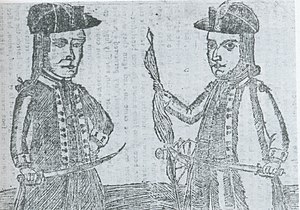Shays' Rebellion
Shays' Rebellion was a rebellion in central and western Massachusetts (mainly Springfield) from 1786 to 1787. The rebellion is named after Daniel Shays, a veteran of the American Revolution who led the rebels, also known as "Shaysites" or "Regulators". Most of the rebels were poor farmers angered by their debt and taxes. They could not pay their taxes and were afraid of going to jail or having their homes taken away from them.

They tried to stop the courts from taking property from indebted farmers by forcing the closure of courts in western Massachusetts. The participants in Shays' Rebellion believed they were acting in the spirit of the American Revolution, modeled their tactics after the crowd activities of the 1760s and the 1770s, and used "liberty poles" and "liberty trees" to symbolize their cause.
Shays' Rebellion started on August 29, 1786, and by January 1787, over 1000 rebels had been arrested. A militia, which had been raised as a private army, defeated an attack on the federal Springfield Armory by the main rebel force on February 3, 1787.
Shays' Rebellion produced fears that the American Revolution's democratic impulse had gotten out of hand. Over time, the farmers grew into armies, controlled by Shays and his men, as they tried to take back their rights.
References
change